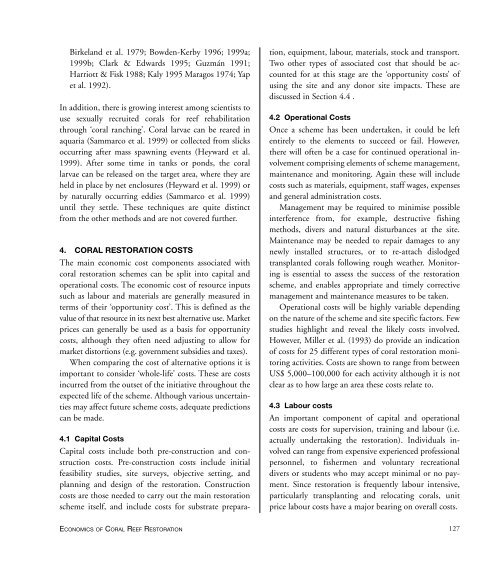Create successful ePaper yourself
Turn your PDF publications into a flip-book with our unique Google optimized e-Paper software.
Birkeland et al. 1979; Bowden-Kerby 1996; 1999a;<br />
1999b; Clark & Edwards 1995; Guzmán 1991;<br />
Harriott & Fisk 1988; Kaly 1995 Maragos 1974; Yap<br />
et al. 1992).<br />
In addition, there is growing interest among scientists to<br />
use sexually recruited corals for reef rehabilitation<br />
through ‘coral ranching’. <strong>Coral</strong> larvae can be reared in<br />
aquaria (Sammarco et al. 1999) or collected from slicks<br />
occurring after mass spawning events (Heyward et al.<br />
1999). After some time in tanks or ponds, the coral<br />
larvae can be released on the target area, where they are<br />
held in place by net enclosures (Heyward et al. 1999) or<br />
by naturally occurring eddies (Sammarco et al. 1999)<br />
until they settle. These techniques are quite distinct<br />
from the other methods and are not covered further.<br />
4. CORAL RESTORATION COSTS<br />
The main economic cost components associated with<br />
coral restoration schemes can be split into capital and<br />
operational costs. The economic cost <strong>of</strong> resource inputs<br />
such as labour and materials are generally measured in<br />
terms <strong>of</strong> their ‘opportunity cost’. This is defined as the<br />
value <strong>of</strong> that resource in its next best alternative use. Market<br />
prices can generally be used as a basis for opportunity<br />
costs, although they <strong>of</strong>ten need adjusting to allow for<br />
market distortions (e.g. government subsidies and taxes).<br />
When comparing the cost <strong>of</strong> alternative options it is<br />
important to consider ‘whole-life’ costs. These are costs<br />
incurred from the outset <strong>of</strong> the initiative throughout the<br />
expected life <strong>of</strong> the scheme. Although various uncertainties<br />
may affect future scheme costs, adequate predictions<br />
can be made.<br />
ECONOMICS OF CORAL REEF RESTORATION<br />
4.1 Capital Costs<br />
Capital costs include both pre-construction and construction<br />
costs. Pre-construction costs include initial<br />
feasibility studies, site surveys, objective setting, and<br />
planning and design <strong>of</strong> the restoration. Construction<br />
costs are those needed to carry out the main restoration<br />
scheme itself, and include costs for substrate preparation,<br />
equipment, labour, materials, stock and transport.<br />
Two other types <strong>of</strong> associated cost that should be accounted<br />
for at this stage are the ‘opportunity costs’ <strong>of</strong><br />
using the site and any donor site impacts. These are<br />
discussed in Section 4.4 .<br />
4.2 Operational Costs<br />
Once a scheme has been undertaken, it could be left<br />
entirely to the elements to succeed or fail. However,<br />
there will <strong>of</strong>ten be a case for continued operational involvement<br />
comprising elements <strong>of</strong> scheme management,<br />
maintenance and monitoring. Again these will include<br />
costs such as materials, equipment, staff wages, expenses<br />
and general administration costs.<br />
Management may be required to minimise possible<br />
interference from, for example, destructive fishing<br />
methods, divers and natural disturbances at the site.<br />
Maintenance may be needed to repair damages to any<br />
newly installed structures, or to re-attach dislodged<br />
transplanted corals following rough weather. Monitoring<br />
is essential to assess the success <strong>of</strong> the restoration<br />
scheme, and enables appropriate and timely corrective<br />
management and maintenance measures to be taken.<br />
Operational costs will be highly variable depending<br />
on the nature <strong>of</strong> the scheme and site specific factors. Few<br />
studies highlight and reveal the likely costs involved.<br />
However, Miller et al. (1993) do provide an indication<br />
<strong>of</strong> costs for 25 different types <strong>of</strong> coral restoration monitoring<br />
activities. Costs are shown to range from between<br />
US$ 5,000–100,000 for each activity although it is not<br />
clear as to how large an area these costs relate to.<br />
4.3 Labour costs<br />
An important component <strong>of</strong> capital and operational<br />
costs are costs for supervision, training and labour (i.e.<br />
actually undertaking the restoration). Individuals involved<br />
can range from expensive experienced pr<strong>of</strong>essional<br />
personnel, to fishermen and voluntary recreational<br />
divers or students who may accept minimal or no payment.<br />
Since restoration is frequently labour intensive,<br />
particularly transplanting and relocating corals, unit<br />
price labour costs have a major bearing on overall costs.<br />
127


















